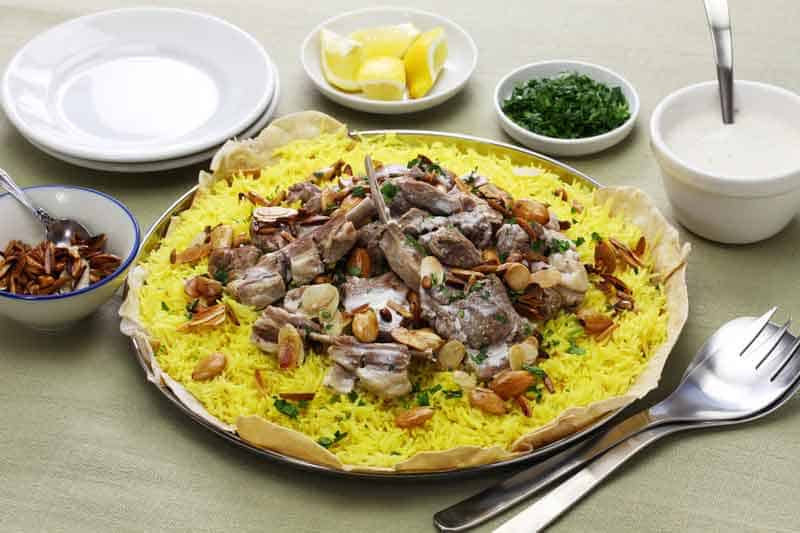
What is Mansaf and why is it special to Jordanians?
Mansaf is at the heart of Jordanian hospitality. This national dish has a rich history as the original version of the dish dates back thousands of years. The Bedouins modified today’s version less than a hundred years after rice was introduced to the area. It was said to be created in Moabite state in the city of Al- Kark in the southern region of Jordan.
When a Moab king decided to fight the Jewish people, he ordered his army to cook meat in milk and use it as a test. Whoever refused to eat it was Jewish! Another story of Mansaf was mentioned in the bible when Ibrahim and his wife Sarah prepared food for a guest. They cooked with a young calf, bread, milk, and curds and served it to their guests under the tree.
There are only a few ingredients to this traditional dish.
As you can guess, they include goat or lamb meat, rice, Jameed, and bread. The secret ingredient to this classic dish is Jameed. Jameed is a dried yogurt that gets rehydrated and then used to make the Mansaf. Even though Jameed is now available as a typical product on the shelf, it has never had the same taste as traditional Jameed.
The southern region of Jordan is known to have the best Jameed.
They make Jameed in the springtime. Few families still make Jameed the old-fashioned way, which is passed on from generation to generation. My family is from that region, and we take pride in making the best Jameed. After the goats give birth and start producing milk, some milk is used for feeding the babies, and some is used to make Jameed.
The first part of the process is separating the butterfat from the goat milk. Then, the butter fat gets strained a couple of times through a cheesecloth to get the richest texture. The following steps are to salt the goat’s milk solids at this stage, which are called Makheed. This will help with the dehydrating process. They are then formed into large balls and dry for three days in a dry place. At this stage, the dry white balls are called Jameed. Jameed can keep in a cool, dry place for a few months!
Jameed is used to make traditional mansaf.
To make the Mansaf, the dry Jameed is broken down into small chunks and soaked in cold water until it gets soft. Large pieces of either lamb or goat meat are cut and cooked in water until they become tender. Some of the stock should be added into the soft broken Jameed and mixed either by blender or hand. The mixture should be a smooth, rich semi-white broth. Then strain the mixture over the cooked meat and cook everything all together until it becomes a rich semi-thick sauce.
Some people add a little Mansafe spice and a spoonful of ghee to give the dish a slightly yellow color. A large pot of short-grain rice is cooked separately. Then take a large platter called seddar and cover it with a thin layer of shrak bread. This is used as a base to assemble the Mansaf. The base is then topped with the cooked rice, followed by the big pieces of meat. Once the meat is arranged on top, we add toasted pine nuts and almonds all over. The Jameed sauce is put in a separate bowl, and we use a ladle to pour the sauce all around the side of the seddar.
There is specific etiquette when it comes to eating the Mansaf.
Guests gather around the Seddar and eat with their right hand while the left hand is placed behind their back. Using the handball of rice and meat created and squeezed gently to shape, then almost roll it into your mouth without your finger touching it. You also only eat from your side of the seddar and do not reach out to other people’s sides. Men and women eat in two separate areas on formal occasions like weddings or large gatherings. Men eat with their right hand while women serve themselves on plates and eat with a spoon.
Mansaf is more than a traditional dish.
It is a core value of the Jordanian people. It brings people together, and enjoying the dish together is a way of showing appreciation, respect, and generosity to your guest. Even today, Mansaf has been known to resolve conflicts between tribes in Jordan. Eating Mansaf is a peaceful way for people in disagreement to come together to find solutions and bring peace.
For as long as I can remember, Mansaf has been served at weddings, funerals, and family gatherings. Some people also just make it a special meal for their family. It’s a meal made with the labor of love.
Jordanian living outside of Jordan still gather with their friends and family and celebrate this traditional dish in their homes.
Whenever we eat this dish, it is like being back in Jordan. The dish makes wherever you live feel like a home away from home. If you ever visit Jordan, be sure to try the Mansaf. Don’t pass up this opportunity to experience this dish’s delicious food and culture.
Bio:
Hi, I’m Rana and I blog at ranasrecipe.com. My passion for food began very early in my life. And after managing a cafe, a granola business and helping other food businesses scale up, I found my true calling in creating wonderful recipes so that everyone can enjoy cooking as much as I do! Don’t forget to follow me on my social channels- instagram and pinterest.
